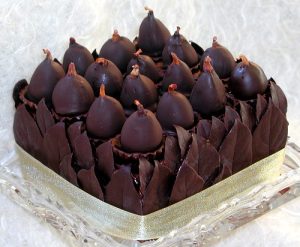Chocolate, a universally loved delicacy, has a rich and varied presence in literature. Its role goes beyond merely satisfying the sweet tooth of characters within the pages of a novel. Throughout history, chocolate has held historical significance, been portrayed as a symbol of indulgence and pleasure, used as a metaphor for temptation or desire, featured in many well-known literary works, reflected cultural and social implications, explored the relationship between food, language, and culture, and more. This article will delve into the various aspects of chocolate in literature, shedding light on its enduring presence and significance. The journey of chocolate in literature is indeed a fascinating one. From its historical significance and portrayal as a symbol of indulgence and pleasure to its use as a metaphor for temptation and desire, chocolate has left an indelible mark on the world of literature, influencing authors and captivating readers for centuries.
The role of chocolate in literature is multifaceted. It serves as a cornerstone of lavish feasts, a comforting companion in times of solitude, a symbol of love and affection, and a tantalizing temptation. Its many forms and uses in literature are a testament to its versatility and appeal. Whether it’s a symbol of wealth and indulgence in a decadent French novel or a metaphor for temptation in a children’s fairy tale, chocolate is a powerful literary device that continues to capture our imagination.
Historical Significance of Chocolate in Literature



The historical journey of chocolate in literature is a captivating one. The cocoa bean, the foundation of chocolate, was brought to Europe from Central America by Spanish explorers during the 16th century. Initially, chocolate was consumed as a hot drink, believed to possess medicinal properties. However, it wasn’t long before it became popular as a social drink, finding its place in the coffee-houses of England and becoming associated with the wealthy elite. British writer Isaac D’Israeli described chocolate as a nourishing and stimulating drink. However, he also criticized it for inflaming passions, highlighting the complex perceptions of chocolate during this period. Tea, coffee, and chocolate were even labeled as dangerous stimulants associated with poor morality. The social implications of chocolate consumption in Christian Europe led to controversies and debates, adding to the fascinating historical context of chocolate in literature.
King Charles II attempted to outlaw coffee and chocolate houses due to suspicions of sedition. Despite these efforts, the Cocoa-tree Chocolate-house in London became a meeting place for Jacobites and was satirized in the play “The Way of the World” as a site of amorous intrigue, gossip, and gambling. As chocolate gained popularity, it became a status symbol and a marker of social class. It was associated with luxury and indulgence, reinforcing the divide between the upper class and the lower class. The historical significance of chocolate in literature lies not only in its introduction to Europe and its association with the wealthy elite but also in the controversies and debates it sparked during its early days. This historical context provides a fascinating backdrop for the role of chocolate in literature, adding depth to its portrayal in various literary works.
Chocolate as a Symbol of Indulgence and Pleasure in Literature
In literature, chocolate is often portrayed as a symbol of indulgence and pleasure. From lavish feasts in grand halls to intimate gatherings in cozy homes, chocolate is a symbol of celebration, decadence, and pure enjoyment. Alexander Pope’s “The Rape of the Lock” links chocolate with indulgence and pleasure. Within the poem, chocolate is depicted as a distraction, an idle pleasure, and even a method of punishment. These portrayals highlight the association of chocolate with indulgence and the luxurious lifestyle of the upper class, further reinforced by its historical association with the wealthy elite.
One example of chocolate symbolizing indulgence and pleasure can be found in the character of Marquise de Merteuil in Pierre Choderlos de Laclos’ “Les Liaisons dangereuses.” The Marquise, a manipulative and cunning character, uses chocolate as a tool to seduce and manipulate others. She presents chocolate as a sensual and pleasurable experience, enticing her targets with its delicious taste and luxurious connotations. Through this portrayal, chocolate becomes a symbol of the Marquise’s extravagant lifestyle and her ability to indulge in her desires without consequence.
The symbolic use of chocolate in literature extends beyond historical novels and satirical poems. In modern literature, chocolate continues to be a symbol of indulgence and pleasure, reflecting our ongoing fascination with this delectable treat. From the sumptuous chocolate feasts in Joanne Harris’s “Chocolat” to the tantalizing descriptions of chocolate in Laura Florand’s “The Chocolate Thief,” the portrayal of chocolate as a symbol of indulgence and pleasure endures, capturing our collective imagination and delighting our senses.
Chocolate as a Metaphor for Temptation or Desire in Literature
Literary works have frequently employed chocolate as a metaphor to represent temptation or desire. The rich, sumptuous nature of chocolate and its association with indulgence and luxury make it an ideal metaphorical device to express these complex human emotions. In 19th-century French novels, chocolate metaphors were used to explore the instability and indeterminacy of human identity. These metaphors also served to highlight power dynamics in our relationship with nature. By using chocolate as a metaphor, authors delve into the complexities of human desires and the allure of temptation.
An example of chocolate being used as a metaphor for temptation can be found in the novel “Chocolat” by Joanne Harris. In the book, the main character, Vianne Rocher, uses her chocolate shop as a means to tempt and seduce the townspeople of Lansquenet-sous-Tannes. Through her delectable chocolates, Vianne stirs up desire and passion in the otherwise restrained and conservative community. The chocolate becomes a metaphor for the forbidden pleasures and hidden desires that lie beneath the surface of the town’s inhabitants.
The use of chocolate as a metaphor extends beyond temptation and desire. In some literary works, chocolate serves as a metaphor for other complex themes such as power, control, and social dynamics. For example, in “The Chocolate War” by Robert Cormier, chocolate is used as a metaphor for power and control, reflecting the manipulative tactics and power struggles within a school setting. Whether it’s expressing forbidden desires or reflecting social dynamics, the use of chocolate as a metaphor in literature offers rich, nuanced insights, adding depth and complexity to the narrative.
Famous Literary Works Featuring Chocolate



Chocolate has made notable appearances in various literary works throughout history. Its presence in these works is a testament to its enduring appeal and its ability to convey complex themes and emotions. One example is Alexander Pope’s “The Rape of the Lock,” where chocolate is associated with upper-class extravagance and revelry. French novels by authors such as Stendhal, Huysmans, Verne, and Nothomb also engage with chocolate as a literary element, using it to explore themes of desire, indulgence, and power dynamics. In popular children’s literature, books like “Matilda,” “Harry Potter,” “The Boxcar Children,” “Charlie and the Chocolate Factory,” and “The Chocolate War” incorporate chocolate-related themes, capturing the imagination of young readers.
In Roald Dahl’s “Charlie and the Chocolate Factory,” chocolate plays a central role in the story. The eccentric chocolatier, Willy Wonka, invites children into his magical chocolate factory, where they encounter fantastical creations such as a river of chocolate and edible wallpaper. Through the chocolate-themed adventures in the story, Dahl explores themes of greed, temptation, and the power of imagination. The presence of chocolate in these famous literary works demonstrates its ability to captivate readers of all ages and serve as a catalyst for storytelling.
The presence of chocolate in literature is not limited to novels and poems. It also features prominently in plays, short stories, and even comic strips. Whether it’s a Shakespearean play where chocolate serves as a symbol of love and affection or a modern comic strip where a chocolate cake triggers a series of hilarious events, the portrayal of chocolate in literature continues to evolve, reflecting our ongoing fascination with this delectable treat. Through its appearances in various literary works, chocolate has made a significant contribution to the literary world, influencing authors, captivating readers, and leaving a lasting legacy.
Cultural and Social Implications of Chocolate in Literature
Chocolate consumption in 18th-century England carried social implications, associating it with the wealthy elite. French literature, in particular, has explored the cultural implications of chocolate, delving into themes of gender, exploitation, and ecological concerns. By examining the cultural and social contexts surrounding chocolate in literature, we gain insights into the values and beliefs of different societies throughout history.
An example of the cultural and social implications of chocolate in literature can be seen in Laura Esquivel’s novel “Like Water for Chocolate.” The novel, set in Mexico during the Mexican Revolution, explores the role of food, including chocolate, in conveying emotions and desires. Through the protagonist Tita’s magical cooking, the novel delves into themes of tradition, female empowerment, and the impact of societal norms on personal freedom. By using chocolate as a cultural symbol, Esquivel highlights the complex relationship between food, culture, and social dynamics.
The cultural and social implications of chocolate in literature extend beyond specific novels or periods. Whether it’s a modern novel exploring the dark side of the chocolate industry or a historical novel depicting the luxuries of the upper class, the portrayal of chocolate in literature reflects the societal values and norms of different periods and cultures. Through its portrayal in literature, chocolate serves as a mirror, reflecting societal attitudes and cultural dynamics, providing valuable insights into the societies in which these literary works were produced.
Chocolate in Literature: Exploring Human Nature
Chocolate serves as a tool in literature to explore questions about human nature and our status as civilized beings. It raises thought-provoking inquiries about our relationship with nature, our desires, and our understanding of ourselves. By using chocolate as a literary device, authors offer a lens through which readers can contemplate modernity, textuality, and our connection to the natural world.
An example of chocolate being used to explore human nature can be found in the short story “Babette’s Feast” by Isak Dinesen. The story revolves around Babette, a French refugee who prepares a sumptuous feast for a small religious community in Denmark. Through her exquisite chocolate dessert, Babette brings joy, pleasure, and a momentary escape from the strict religious confines of the community. The chocolate becomes a symbol of the human capacity for pleasure and the transformative power of food.
The exploration of human nature through chocolate is not limited to specific literary works or genres. Whether it’s a novel delving into the complexities of human desires and temptation, or a play exploring the power dynamics and societal norms surrounding chocolate consumption, chocolate serves as a powerful tool for exploring human nature. Through its various portrayals in literature, chocolate prompts readers to reflect on their own desires, values, and relationships with the world around them.
Chocolate in Literature: Linking Food, Language, and Culture
In literature, chocolate serves as more than a mere food item. It becomes a means to explore the intricate relationship between food, language, and culture. Author Amélie Nothomb, in particular, emphasizes the connection between chocolate, language, and the divine in her writings. Through the exploration of chocolate’s cultural significance, authors shed light on the ways in which food shapes and reflects cultural identities.
An example of chocolate linking food, language, and culture can be found in Laura Esquivel’s novel “Like Water for Chocolate.” The protagonist, Tita, uses her culinary skills to communicate her emotions and desires. Her chocolate-based recipes become a form of expression, allowing her to convey her love, longing, and rebellion against societal norms. Through the language of food, especially chocolate, Esquivel explores the intersection of culture, identity, and personal expression.
The exploration of the relationship between food, language, and culture through chocolate is a fascinating aspect of literature. Whether it’s a novel exploring the cultural significance of food or a poem using food as a language to express emotions, chocolate serves as a powerful tool for exploring these intricate connections. Through its various portrayals in literature, chocolate invites readers to contemplate the ways in which food, language, and culture intersect, influence each other, and shape our identities and experiences.
Chocolate: From Medicine to Delicacy
The evolution of chocolate, from a medicinal substance to a beloved delicacy, is a fascinating journey. Chocolate’s use as medicine originated in Mesoamerican civilizations and was introduced to Europe in the 16th century. However, controversies and debates arose regarding the medical use of chocolate in Christian Europe. While some advocated for its beneficial effects, others criticized its potential negative consequences. Over time, the perceptions of chocolate shifted, and it became more associated with indulgence and pleasure than with medicine.
The shift from chocolate as medicine to chocolate as a delicacy can be seen in the works of Marcel Proust, particularly in his famous novel “In Search of Lost Time.” In the novel, the protagonist experiences a flood of memories and emotions when he tastes a madeleine dipped in a cup of hot chocolate. The chocolate becomes a sensual experience that triggers a sense of nostalgia and pleasure. Proust’s portrayal of chocolate highlights its transformation from a medicinal substance to a symbol of indulgence and sensory delight.
The journey of chocolate from medicine to delicacy is a testament to its enduring appeal and versatility. Whether it’s a historical novel depicting the medicinal uses of chocolate in ancient civilizations or a modern novel exploring the sensory delight of a chocolate dessert, the portrayal of chocolate in literature reflects its rich history and evolving perceptions. Through its various portrayals in literature, chocolate invites readers to contemplate its journey, from its origins in Mesoamerica to its place in contemporary society, and how this journey is reflected in our cultural and societal attitudes towards this beloved treat.
Shift in Chocolate Consumption and its Portrayal in Literature
The 19th century witnessed significant changes in chocolate production and consumption, which influenced its portrayal in literature. These changes reflected the cultural and social shifts surrounding chocolate during that time. As society’s perception of chocolate transformed, authors incorporated these evolving dynamics into their literary works, capturing the changing attitudes towards this beloved treat. The shift in chocolate consumption and its portrayal in literature offer valuable insights into the socio-cultural dynamics of the period and the evolving role of chocolate in society.
One example of the shift in chocolate consumption and its portrayal in literature can be found in the novels of Emile Zola. In his novel “The Ladies’ Paradise,” Zola explores the rise of consumer culture and the emergence of modern department stores. Chocolate becomes a symbol of the changing tastes and desires

